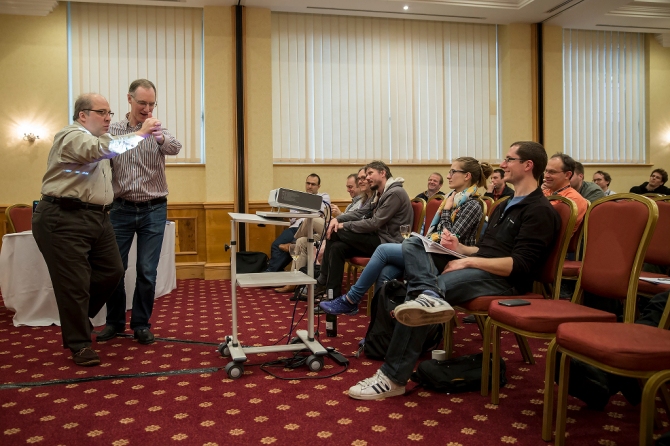Perceiving Organising Principles requires us to develop a living and mobile thinking perception.
Unfortunately, as programmers, we are at a disadvantage.
We work in a domain where a lot of our thinking needs to be fixed into a rule-based structure in order to imagine how a computer program will function. This can have unwanted side effects of making it difficult to think in a mobile, living way. Multi-threaded programming demands this mobile thinking and is why it is so difficult.
At a personal level if we want to develop this other way of seeing we need to engage in some activities that foster that mobile mode of cognition. Perceiving livingness, almost by definition, requires that we need to handle ambiguity. This is what is required when we are working in the ‘gap’, or whenever we are dealing with human situations.
Logical thinking can cope with known and static issues, but as programmers we need to be very aware of the boundaries of our knowledge, more so than the lay person due to the inherent fixity of the domain of computer programming.
Alexander Revisited
At this point it is useful to look at some of Christopher Alexander’s ideas about the perception of beauty and links to what I have been saying about the idea of Cognitive Feeling.
Alexander started with defining a Pattern Language to help foster good architectural design – what he called Living Structure. This metamorphosed into his masterwork, The Nature of Order where he tried to get a better understanding of why we find certain structures beautiful.
In the Nature of Order, Volume 1 Chapter 5, he identified the following 15 properties of Living Structure:
- Levels Of Scale
- Strong Centres
- Boundaries
- Alternating Repetitions
- Positive Space
- Good Shape
- Local Symmetries
- Deep Interlock And Ambiguity
- Contrast
- Gradients
- Roughness
- Echoes
- The Void
- Simplicity And Inner Calm
- Not-Separateness
If you just look at this as a list of items, it can be difficult to understand how these may be useful in design, apart from as heuristic guidelines. Although useful, if we look at them in the light of the dynamic concept of the Organising Principle, they make a lot more sense.
A major point is Alexander’s use of the word: Living. As I point out, this implies ambiguity. Therefore these 15 Properties can be seen instead as Organising Principles and when we try and ‘bring them down’ into a more fixed understanding we will only be seeing one way of looking at each one.
Perceiving the Organising Principle as a Disciplined Artistic Process.
In order to develop a mobile dynamic cognition that can better perceive Organising Principles, my thesis is that we need to take up some artistic pursuit in a disciplined and self-aware way. Do whatever appeals to you. For me I find painting and dance work well.
Lets look at how the practice of these pursuits parallels software development, or indeed any technical effort.
The following image is a watercolour painting of my daughter.

Freehand painting based on photo of my daughter.
This was one of my first forays into the world of painting and like the good novice artist I was, I decided to draw the picture first, using a photograph as a reference.
It took me 3 hours!
The first effort took 2 hours. The next took 1 hour and the last two each took half an hour, with the final result intended as the basis for the final painting. Being the worried novice that I was I decided to perform a ‘colour check’ painting freehand before doing the final version. In the end this became the final painting I have included here as I found that when I tried to paint into the final drawing it did not have the same life as the freehand painting.
This is an example of the difference between the ‘master’ freehand approach as compared to the ‘journeyman’ drawn approach. Of course I do not consider myself to be a master painter, but this example illustrates the self-developmental dynamic inherent in the artistic process.
We can also see here the need to do the foundational, ‘analytic’ work, in this case the drawing; followed by the ‘gap’ of putting the drawing away and using the freehand skill to come up with the ‘solution idea’.
The following is a painting by Jim Spencer and is for me an example of how less is more and illustrates how such minimalism is an essential aspect of any mastery. In this case Jim began learning art just after the second world war. (Also see my post Minimalist Mastery)

The third example of and artistic pursuit is that of dance, in this case Argentine Tango. This particular dance is a form strongly founded on being far more conscious about what is a primary human activity: walking. (See my post on Dance as True Movement)
Here there is a need for structure, and a mobile process of interpretation and improvisation, both founded on a disciplined form of the dance. It can take years to learn how to ‘walk’ again but if followed in a disciplined manner can lead to sublime experiences of ‘Living Structure’ as the ‘team’ of two people dance from a common centre of balance.
In conclusion I hope you have been able to see the implicit link between Art and Technology and the value of balancing ourselves up as human beings.
Thank you for your attention.
In response to my statement about dancing John Lakos (author of Large Scale C++ Software Design) asked for some tango teaching at the end of the talk! The picture was taken by Mogens Hansen.

←ACCU2016: Talk on Software Architecture Design 6: Organising Principles

Thiis is great
Thanks for your comment Bryson. Glad you like it.